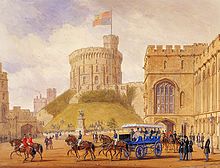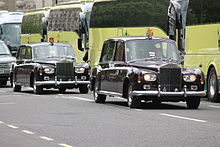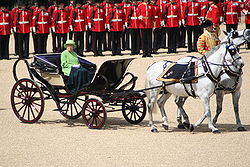Royal Mews

The Royal Mews is a mews, or collection of equestrian stables, of the British royal family. In London these stables and stable-hands' quarters have occupied two main sites in turn, being located at first on the north side of Charing Cross, and then (since the 1820s) within the grounds of Buckingham Palace.
The Royal Mews, Buckingham Palace, includes an extensive display of royal carriages and other associated items, and is open to the public for much of the year. It is also a working part of the palace, where horses and people live and work, and where carriages and cars are in daily use supporting the work of the monarch as head of state.
The titular head of the Royal Mews is the Master of the Horse (one of the three great officers of the Royal Household). The executive head is the Crown Equerry, who lives on site and oversees the Royal Mews Department (which is a department of the Royal Household).
History
[edit]At Charing Cross
[edit]
The first set of stables to be referred to as a mews was at Charing Cross at the western end of The Strand. The royal hawks were kept at this site from 1377 and the name originates from the fact that they were confined there at moulting time ("mew" being derived from the French verb "muer", to moult).[1]
In the Tudor Period, the Royal Stables were located in Lomesbury (present-day Bloomsbury).[2] In 1534 they were destroyed by fire, whereupon the King, Henry VIII, decided to rebuild the Charing Cross mews as a stables (the hawks having been given alternative accommodation). It kept its former name when it acquired this new function. On old maps, such as the "Woodcut" map of London of the early 1560s, the Mews can be seen extending back towards the site of today's Leicester Square.
When George I came to the throne in 1714 he brought with him to London the famous cream stallions which he was wont to use as Elector of Hanover.[3] Bred at the Royal Stud at Hampton Court, these horses pulled state carriages in England for the next two hundred years (except for a hiatus during the Napoleonic wars when George III used black stallions in protest at the French occupation of Hanover).

The mews was rebuilt again in 1732 to the designs of William Kent, and in the early 19th century it was open to the public. This building was usually known as the King's Mews (or Queen's Mews when there was a woman on the throne), but was also sometimes referred to as the Royal Mews or the Royal Stables.

Kent's redesign was a classical building occupying the northern half of the site, with an open space in front of it that ranked among the few large ones in central London at a time when the Royal Parks were on the fringes of the city and most squares in London were garden squares open only to the residents of their surrounding houses.
On 15 June 1820, the Guards in the Royal Mews mutinied in support of Caroline of Brunswick, whom King George IV was seeking to divorce.[4]
The whole site was cleared in the late 1820s to create Trafalgar Square, laid out in 1837–1844 after delays, and the National Gallery which opened in 1838.[5]
At Buckingham Palace
[edit]
The present Royal Mews is in the grounds of Buckingham Palace, to the south of Buckingham Palace Gardens, near Grosvenor Place.
In the 1760s George III moved some of his day-to-day horses and carriages to the grounds of Buckingham House, which he had acquired in 1762 for his wife's use. The Riding School, thought to be by William Chambers, dates from this period (it was completed in 1764; the pediment, with sculptural motifs by William Theed, was added in 1859).[6] The main royal stables housing the ceremonial coaches and their horses remained at the King's Mews, Charing Cross; however, when his son George IV had Buckingham Palace converted into the main royal residence in the 1820s the whole stables establishment was moved there.

The current Royal Mews was built to designs by John Nash and was completed in 1825 (though the mews buildings have been modified extensively since). The main quadrangle was laid out with coach houses on the east side, and stable blocks (alternating with harness and forage rooms) on the west.[3] Beyond it, the 'back mews' included accommodation for a veterinary surgeon.

When Victoria came to the throne in 1837, Buckingham Palace became the monarch's principal residence. Prince Albert used the back mews for stabling his own horses (for riding and driving). By the 1850s there were just under two hundred people employed at the mews, most of whom lived on site with their families.[3] Standing either side of the entrance were official residences (one for the Crown Equerry, the other for the Clerk of the Stables); other staff were accommodated in rooms above the stables and carriage houses. In 1855 Queen Victoria established a Buckingham Palace Royal Mews School, for the education of the workers' children.

Under Victoria's successor, King Edward VII, motor vehicles were introduced into the mews. In 1904 the Crown Equerry wrote to the Office of Works to request the conversion of 'two small coach-houses in the Back Mews' into 'a suitable Motor House [...] with a Lantern roof, hot water heating apparatus and electric lighting'.[7] The conversion duly took place, and accommodation was provided nearby for the chauffeurs.

In the early 20th century problems had arisen due to inbreeding of the Hanoverian creams. In 1920 they were withdrawn from use and in their place, for the rest of the decade, bay horses took pride of place in the Mews.[6] In the early 1930s, however, King George V began using grey horses for the lead carriages in state and ceremonial processions; his son and heir Edward VIII moved the grey horses from Windsor (where they had been used for many years by the Royal Family for their private carriages) to London, where they were nicknamed the 'Windsor Greys'.[3]
By 1936 motor vehicles were in the ascendency, and following his accession to the throne Edward VIII disposed of several of the more 'day to day' carriages. George VI made more disposals after the Second World War: for example, sixteen plain Edwardian town coaches were sold off at this time (just one remained, stored away at Windsor; it was later rediscovered, glazed and restored to royal use). A total of nineteen carriages were purchased by Sir Alexander Korda after the war, for use as film props; of these, five Clarences were borrowed back in 1953 for the coronation (to supplement five identical carriages which had been retained by the Mews).[8] The coronation that year involved thirty-four coaches and carriages with seventy-eight horses in harness.
In 1988 a new state coach was presented to the Mews, the Australian State Coach, built by former Mews employee W. J. Frecklington as part of the Australian Bicentenary celebrations; it was the first new royal state coach to be built since the 1902 State Landau.[3] At that time, despite the earlier disposals, the Royal Mews still had custody of over a hundred vehicles, with all but a dozen being in working order; the majority were in London or Windsor, with others spread around the other royal residences.
Present day
[edit]
As well as being a full-time working facility, the Royal Mews, Buckingham Palace, is regularly open to the public. The state coaches and other carriages are kept there, along with about 30 horses, together with their modern counterparts: the state motor cars. Coachmen, grooms, chauffeurs and other staff are accommodated in flats above the carriage houses and stables.
Carriage horses
[edit]The complement of horses in the Royal Mews today includes around a dozen Windsor Greys and eighteen Cleveland Bays.[6] The horses are regularly exercised in the art of pulling carriages (which is one of the reasons for the continuing use of horse-drawn transport for the daily messenger rounds between Buckingham Palace and St James's Palace); they are used for competitive and recreational driving as well as for ceremonial duties. The manure that is produced by the horses is used by the adjacent Buckingham Palace Garden.
Royal and state carriages
[edit]A few of the carriages stored at the Mews are pictured here in action; several more are illustrated on their own pages (see listing below).
-
A clarence from the Royal Mews, drawn by a pair of Cleveland Bay horses, passing the Victoria Memorial. (A clarence is a larger-than-standard, two-horse brougham.)
-
One of two Royal Mews barouches carrying members of the Royal Family at the 2009 Trooping the Colour.
-
Queen Elizabeth II riding in a phaeton, drawn by Windsor Grey horses, at the 2007 Trooping the Colour. (This carriage is known as the "Ivory-mounted Phaeton".)
-
"Ascot" landau conveying bridesmaids back from Westminster Abbey to Buckingham Palace after the wedding of the Duke and Duchess of Cambridge, 2011.
-
The "Balmoral" sociable in use for Trooping the Colour, 2016.
-
The "Balmoral" landau conveying the Countess of Wessex and others from Trooping the Colour, 2018.
Vehicles in the care of the Royal Mews are listed below. A good number are on public display, though not all are kept in London.[9] Most are in regular use, and some (for example, the broughams) are driven on a daily basis.[a] Others (above all the Gold Coach) are only used on great and rare state occasions. The list includes vehicles for personal, recreational and sporting use, as well as those designed and kept for state occasions:



- The Gold State Coach
- The Irish State Coach
- The Scottish State Coach
- The Australian State Coach
- The Diamond Jubilee State Coach
- Queen Alexandra's State Coach
- The Glass Coach
- King Edward VII's Town Coach
- Several landau carriages including:
- The 1902 State Landau
- Seven other state landaus
- Five semi-state landaus
- Five Ascot landaus
- Barouches and sociables
- Broughams and clarences
- Phaetons and victorias
- Sporting carriages, including a rare curricle
- Recreational vehicles, such as the Louis-Philippe charabanc (illustrated)
- A variety of pony carriages, drags and exercise vehicles
In less regular use is Queen Victoria's state sledge, one of a number of royal sleighs in the Mews.
Also on display are some of the historic and immaculately kept liveries and harnesses (which likewise see regular use), ranging from the plainer items used for exercising and working horses, to the ornamented state liveries and harnesses designed for use with the similarly appointed state coaches.
Motor vehicles
[edit]
The maintenance and provision of modern motor vehicles is as much a part of the work of the Royal Mews as that of carriages and horses. Edward VII first established a garage in the Mews in the early years of the twentieth century.
The principal official cars are all painted in black over claret (known as Royal Claret).[10] They are driven, cared for and maintained by a number of chauffeurs, who are based in the Mews and work under the head chauffeur (who, along with his deputy, is primarily responsible for driving the monarch).[3]
State cars
[edit]
The five principal state cars are without number plates. They comprise:
- Two identical Bentley State Limousines (one was given to Queen Elizabeth II in 2002 to mark her Golden Jubilee, the other was purchased at the same time).
- Two Rolls-Royce Phantom VI limousines: the 1978 Silver Jubilee Phantom VI and a 1986 Phantom VI, both nearly identical outwardly, save for the slightly higher roof on the 1978 example (see photo).
- A rare 1950 Rolls-Royce Phantom IV with body by HJ Mulliner & Co., the first example of this model built; it was fitted with an automatic gearbox in 1955.
Other official vehicles
[edit]The following vehicles, used for less-formal occasions and as support vehicles, are similarly painted in the royal claret and black livery:
- Three Daimler DS420 limousines, two dating from 1992 (number plates KLL1 and K326EHV) and one from 1988 (F728OUL).[11]
- Two 2012 Jaguar XJ limousines (number plates NGN 1 and NGN 2).
- Three 2022 Range Rovers (number plates MYT1, MYT 2 and MYT 3).
- The State Hearse commissioned for the funeral of Elizabeth II.
Land Rovers, luggage brakes and people carriers are also kept at the Royal Mews. A number of electric vehicles have been acquired since 2012, for various purposes, ranging from a BMW i3 and a BMW 7 Series hybrid to a Nissan van and a Renault Twizy.[12]
-
1950 Rolls-Royce Phantom IV limousine
-
2012 Jaguar XJ limousine
-
Daimler DS420 limousine
The Royal Mews Department
[edit]The following chart shows the staff structure of the Royal Mews Department at the end of the twentieth century (when around fifty people lived and worked at the Mews).[13] The position of Superintendent, which included oversight of the staff of the Mews, was abolished in 2000.[6]
| Crown Equerry | |||||||||||||||||||||||||||||||||||||||||||||||
| Superintendent of the Royal Mews | |||||||||||||||||||||||||||||||||||||||||||||||
| Veterinary Surgeon | Horsebox Driver of Windsor | Stud Groom of Hampton Court | Stud Groom of Windsor | Comptroller of Stores | Chief Clerk | ||||||||||||||||||||||||||||||||||||||||||
| Storeman | Carriage Restorers | Daily Ladies of London | Daily Ladies of Windsor | Deputy Chief Clerk | |||||||||||||||||||||||||||||||||||||||||||
| Head Chauffeur | Head Coachman | Assistant Chief Clerk | |||||||||||||||||||||||||||||||||||||||||||||
| Deputy Head Chauffeur | Deputy Head Coachman | ||||||||||||||||||||||||||||||||||||||||||||||
| First Chauffeurs | Sergeant Farrier | Rough Rider | Senior Liveried Helpers | Carriage Cleaners | Yardmen | ||||||||||||||||||||||||||||||||||||||||||
| Second Chauffeurs | Liveried Helpers | ||||||||||||||||||||||||||||||||||||||||||||||
Other locations
[edit]
The Royal Mews, Hampton Court Palace overlooks Hampton Court Green. It continues to provide accommodation for royal staff, and horses are stabled there from time to time. It is not open to the public.
There is a working Royal Mews at Windsor Castle where the Ascot carriages are normally kept, together with vehicles used in Windsor Great Park. Some horses for riding (rather than driving) are also stabled here.
At Holyrood, the Royal Mews (situated in Abbey Strand) is one of the oldest parts of the Palace, and is still pressed into service whenever royal carriages are used in Edinburgh.
Historically, the old stables of St James's Palace, which stood where Lancaster House is now, were also sometime referred to as the Royal Mews.
See also
[edit]Notes
[edit]- ^ Since 1843, the daily messenger brougham has set out from the Royal Mews to collect and deliver post between Buckingham Palace and St James's Palace.
References
[edit]- ^ "Moult - Definition in the English-French Dictionary - Cambridge Dictionary". dictionary.cambridge.org. Retrieved 10 September 2022.
- ^ Ackermann, Rudolph (1904). The Microcosm of London (vol. II). London: Methuen and Co. p. 162. Retrieved 12 December 2023.
- ^ a b c d e f Stewart-Wilson, Mary (1991). The Royal Mews. London: The Bodley Head. p. 187.
- ^ Robins, pp. 126–127
- ^ "National Gallery - About the building". nationalgallery.org.uk. Retrieved 10 September 2022.
- ^ a b c d Vickers, Hugo (2012). The Royal Mews at Buckingham Palace. London: Royal Collection Enterprises Ltd.
- ^ Smith, Brian E. (1976). Royal Daimlers. Brentwood, Middlesex: Transport Bookman Publications. p. 30.
- ^ Wheeling, Ken (May 2013). "Coaches and Carriages at a Coronation". The Carriage Journal. 51 (3): 144–151.
- ^ 'The Royal Mews, Buckingham Palace', Pitkin, London, 1973 &1990
- ^ The Royal fleet of limousines
- ^ Vanik, Christian (January 2020). "Her Majesty's DS420 Limousines". The Driving Member. 56 (8): 4. Retrieved 16 July 2024.
- ^ Javed, Saman (15 October 2021). "HOW ECO FRIENDLY IS THE QUEEN?". The Independent. Retrieved 2 November 2021.
- ^ Allison, Ronald; Riddell, Sarah, eds. (1991). The Royal Encyclopedia. London: Macmillan and Co. Ltd. pp. 464–467.
External links
[edit]- Official website

- Royal Mews at Buckingham Palace, London. The Monarchy Today > Ceremony and symbol > Transport > Carriages.
- Buckingham Palace
- Carriage museums in England
- Equestrian museums in the United Kingdom
- Grade I listed buildings in the City of Westminster
- Grade I listed museum buildings
- Grade I listed stables
- John Nash buildings
- Mews streets in London
- Museums in the City of Westminster
- Regency architecture in the United Kingdom
- Regency London
- Royal buildings in London
- Transport museums in London
- Streets in the City of Westminster










